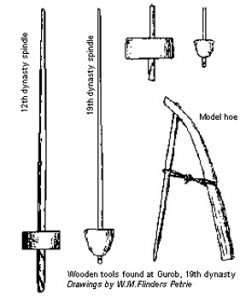Wood, ivory, bone and stone have been used for making tools since earliest times. Wood has marvellous qualities for which it is used and loved to this day. It combines toughness and pliability and can be given almost any shape. It was part of many tools, generally forming the handle. But some tools were made entirely of wood and remained so through the millennia. Ploughs did not have a European-style ploughshare. There was no need to turn over the soil, as the Nile deposited nutrients with every yearly flooding. Used only to break up the topsoil, they continued to be lightly built. Hoes, rakes and grain scoops too were made of wood as were some tools mostly women used, such as spindles and looms. Carpenters’ mallets were often just blocks of wood with a handle. Fire drills consisted of a wooden bow and a plant fibre string. Many of these tools changed but little over the centuries. The spindles of the twelfth dynasty for instance had whorl of greater depth than those of the New Kingdom and at the top a long spiral groove for the thread. In Roman times this groove was replaced by a metal hook.
